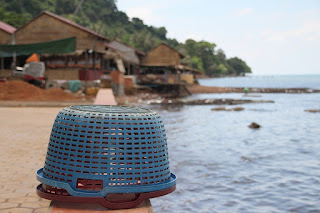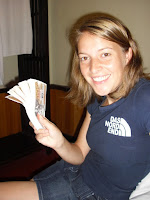Namaste. Our most recent post hasn't even celebrated it's two-day birthday yet but here we are once again stealing your precious time with this new post. To make it more bearable, we'll try to keep it short. The reason for this unusual buzz of activity is that we are heading out from our current location in Kathmandu to go on a 2-3 week (!!) trek around the Annapurna mountain range in the Himalayas tomorrow. I don't expect an awful lot of internet access there.
Anyway, this little post will cover our limited time in Malaysia (the peninsula) and Singapore (the insula – I know that's not even a proper English word, but hey, it sounds clever).
Having landed in Kuala Lumpur (please note that we didn't take a bus for a change), Judith & I were thrilled to be in a developed developing country. The big advantage of a developed developing country like Malaysia is to have the best of both worlds: the benefits of modern civilisation (like clean toilets, wohooo!), while maintaining low prices and an exotic feel (like spices seriously testing your facial perspiration).
The next stop on our route was Melakka, some three hours South of KL. Owning Melakka must once have been fashionable among the world's colonial powers, since the Portuguese, the Dutch, and the British all decided to run it at some point in time. Today, the importance of the city as a trading hub might have faded, but the beautiful colonial heritage makes it a favourite tourist destination for Malaysians and foreign tourists alike. Again, the mix of influences, this time including more European stuff, was cool. In one of the streets, we found a mosque, a Christian church, a Hindu temple and a Chinese Buddhist-Confucianist temple virtually next to each other.
Originally, we had planned to spend more time in the rural parts of Malaysia including some quality beach time, but we had to change our plans on short notice and leave for Singapore earlier than anticipated.
We got a first taste of the impressive structures in Singapore at the freakishly huge & modern border station (entering on, guess what, a bus!). Singapore is different – the state is run by a very strong government, which is world famous for imposing fines and sometimes limiting civil liberties of its underlings. Critics have referred to the city state as “Disneyland with a death penalty” and say it is as much fun as “a Californian beach resort run by Mormons”. However, if you come to Singapore, you will notice that most things run extremely smoothly, and it seems like most voters are fairly happy. For example, the city is as clean as a conservative Southern German village (i.e. very), it's safe, there are plenty of playgrounds for young families, it's an economic powerhouse, and public transport even beats Japan – just to name a few! The most interesting feature of Singapore, at least from my perspective, is once again the melting pot atmosphere and international flair. We had long discussions about the pro's and con's of Singapore's approach, but I won't get into this here. For one, I haven't really made up my mind yet, and second, as promised, I'll try to keep it short today.
Anyway, for the first few days, we stayed in Little India, which really reminded us of our time in India some four years back – just a lot cleaner. Actually, we were kind of relieved to see that not everything in Singapore is glass & steel - there are some old parts of town as well. Tststs, sentimental Europeans.
On the third day, I had to fly back to Frankfurt to take care of some bizness (that's why we had to come to Singapore earlier than originally planned), while Judith would stay in Singapore. The only problem with that was my looks: you might recall some of my more recent pictures... I didn't really look fit for business, with all that lavishly long hair, worn out shorts, and flip-flops marks on my feet. To tackle this, I managed to get my hair cut and buy a suit, shirts, ties, shoes, a belt, cuff links, and a proper wallet, all pretty much within one day. Thankfully, Singapore appears to be the place with the highest density of shopping centres in the world.
While I was feeling important flying back and forth to Frankfurt for just two days, Judith spent some more time enjoying the city. She particularly loved the Botanic Gardens (actually, Singapore is very, very green, and native tropical rainforest covers a substantial part of the island) and the world-famous Zoo (see the first picture of this post). There are some very strange-looking animals in that Zoo – for example, what the heck is that thing on the right hand side below? The Zoo also offers a popular night safari, which is really worth seeing.
The best thing about Singapore for us, though, was that we knew some true locals: Raj and his wife showed us around Little India, including taking us to a very interesting temple, and treating us to some lovely Southern Indian food. Kuan Wai even spent a whole day with us, including inviting us to a fabulous all-you-can-eat-but-very-high-quality lunch buffet on the 70th story of a high-rise. We've never been in a 70-story skyscraper before (I don't think there even is one in Western Europe), let alone had we had lunch there. The views were stunning. Barely being able to walk after all that food, we explored some more parts of the city, among others visiting the new casino complex. In the evening, Kuan Wai's wife joined us as we headed to a local beach and, once again, had some great food. Come to think of it, all Singaporeans seem to be crazy about food.
Sadly, we eventually had to leave Singapore, flying to Kathmandu via Bangkok. I've just noticed that this post isn't that short after all. Sorry, but there was just so much to write about... Malaysia and Singapore are great places. My present to Judith for her b'day tomorrow is another hazardous bus ride, which regular readers will know she loves. After that, we'll start our 3-week trek (Annapurna Circuit) right away. If you don't hear back from us before let's say five weeks from now, please send a rescue team. So long and goodbye.














































